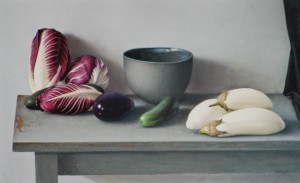Color, light, and eggplant
Representational painting tends to defeat the colorist. The challenge is always to take the hue that’s actually there in what you see and somehow build musical harmonies with it. You’re torn between the pleasure of rendering objects exactly as they look or working away from them toward an image that has its own inner logic, as Cezanne, Braque, Matisse, Morandi, Porter and many other modernists have done. How to build a picture that’s as much about color as it is about the isness of ordinary things, their light and shadow and heft—it’s a delicate balance that has to be renegotiated with every new picture. Amy Weiskopf’s still lifes zero in on the unique opportunity that still life affords for total control of the image, and she uses that freedom to evoke difficult color harmonies by carefully picking and arranging objects and backdrops as she stages her paintings. When I brought the little brochure of reproductions from her current show back to my home-away-from-home in Chelsea, the Viridian Gallery, and I showed the images to Lauren, a friend who works there, she said, “But they’re so set up.” That’s the thing, exactly: Weiskopf’s still lifes hint at a heightened mindfulness through an artificial presentation of natural objects, and either you see the poetry inherent in this centuries-old tradition, or you don’t. Weiskopf’s talent for this demonstrates why still life is the representational genre that most closely resembles abstraction in the privilege it offers a painter to select and arrange the elements of a picture at will. Simply by choosing and placing objects in a given setting, you can dictate everything about the image, its color, lighting, composition, form, and line . Ironically, though, a still life unified by its color relationships can be easier to do if, like Porter or Matisse, you present a table of objects in its accidental environment, giving the impression that what you see is what the artist simply happened upon. Expanding a still life by surrounding it with an interior can make it easier to build an image with color and light, taking more liberties with how individual objects actually look as you stand back from everything to take it all in. And, if you’re Matisse or Porter or Morandi, you flatten the image up to the picture plane, you make paint and color nearly the whole point of the image, altering each hue until it plays well with others, enjoying all the prerogatives of a Greek god with what you’re showing. I’m not knocking it. It’s marvelous.
Yet to paint a lemon or a radish as assiduously as Zurburan and yet still eek out a particular range of coordinated purples, blues, yellows, grays, or reds in the brightly illuminated picture as a whole—and locate these colors against a wall that bathes the entire scene with a certain delicate enveloping tone—it’s a masterful achievement, where all the feeling condenses itself into small areas of understated, well-behaved hues. If you want to see this done beautifully, check out the show of Weiskopf’s commanding still lifes at Hirschl & Adler, in the ICM building on Fifth Ave. It opened Thursday with a couple pieces already sold out of what had to be nearly 20 canvases—representing two years of labor. They are so modestly scaled that the entire show fits comfortably into their small central gallery. It was the first show I saw on my tour of openings last Thursday. I rode the subway up from Chelsea to see this work before I headed back downtown for the rest of the day, and all day long, I kept wishing, instead, that I’d saved the best for last.

This was so meticulously done, I thought you had painted it. I really liked it a lot.